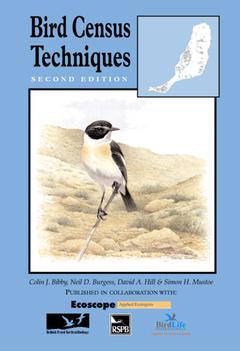Bird Census Techniques (2nd Ed.)
Langue : Anglais
Auteurs : Bibby Colin J., Burgess Neil D., Hill David A., Mustoe Simon

In this book there are entire chapters devoted to the most widely used bird counting techniques, and attempts to amalgamate other counting methodologies into major groups were made. Examples of the use of methods are provided wherever possible and the relative value of various approaches for answering specific questions is also addressed.
Purpose and Design in Counting Birds.
Census Errors.
Territory Mapping Methods.
Line Transects.
Point Counts and Point Transects.
Relative Measure for Bird Communities in Habitats with High Species Richness.
Catching and Marking.
Counting Individual Species.
Counting Colonial Nesting, Flocking and Migrating Birds.
Distribution Studies.
Description and Measurement of Bird Habitat
Census Errors.
Territory Mapping Methods.
Line Transects.
Point Counts and Point Transects.
Relative Measure for Bird Communities in Habitats with High Species Richness.
Catching and Marking.
Counting Individual Species.
Counting Colonial Nesting, Flocking and Migrating Birds.
Distribution Studies.
Description and Measurement of Bird Habitat
Serious ecologist or ornithologist either engaged in research, as a consultant or a serious and interested amateur.
Colin Bibby is Director of Science and Policy at the International Council for Bird Preservation where he is interested in the role of birds as indicators for global biodiversity conservation. While Head of Conservation Science at the Royal Society for the Protection of birds, he was a co-author of Red Data Birds in Britain. In both capacities, he has been struck by the small number of birds of conservation concern which have been counted adequately. He has counted birds in Britain and Europe, as a professional, as an amateur participant, and as an organizer of surveys for the British Trust for Ornithology. He was motivated to start this book by the belief that bird-watchers would contribute more to conservation if they put more effort into counting birds, but lack of guidance on methods was a handicap.
Neil Burgess completed a B.Sc. in Botany and a Ph.D. in Palaeobotany (evolution of the earliest land plants), after which he started work at the Royal Society for the Protection of Birds. He worked on reserves and in the headquarters in Sandy on the management of habitats for birds. During this time the main work on the first edition of Bird Census Techniques was completed. In 1990 he became more involved with African conservation and biodiversity research through project management in the Africa Section of the International Department of the RSPB, and as Research Director of the Society for Environmental Exploration. Most of his work concentrated on tropical forest and wetland habitats in Africa and Southeast Asia, including ornithological surveys. He moved to the Danish Center for Tropical Biodiversity at the University of Copenhagen in 1994 to coordinate and develop programs aiming to map the distribution of biodiversity in Africa. He also worked as International Project Development Officer for the Danish Ornithological Society in 1995-1998. He has maintained an interest in ornithological survey work in Europe, but has moved increasingly into project managemen
Neil Burgess completed a B.Sc. in Botany and a Ph.D. in Palaeobotany (evolution of the earliest land plants), after which he started work at the Royal Society for the Protection of Birds. He worked on reserves and in the headquarters in Sandy on the management of habitats for birds. During this time the main work on the first edition of Bird Census Techniques was completed. In 1990 he became more involved with African conservation and biodiversity research through project management in the Africa Section of the International Department of the RSPB, and as Research Director of the Society for Environmental Exploration. Most of his work concentrated on tropical forest and wetland habitats in Africa and Southeast Asia, including ornithological surveys. He moved to the Danish Center for Tropical Biodiversity at the University of Copenhagen in 1994 to coordinate and develop programs aiming to map the distribution of biodiversity in Africa. He also worked as International Project Development Officer for the Danish Ornithological Society in 1995-1998. He has maintained an interest in ornithological survey work in Europe, but has moved increasingly into project managemen
- A newly revised edition of the immensely successful Bird Census Techniques
- An entirely new chapter covering the census methods recommended for tropical habitats
- Provides a concise guide to various census techniques and their opportunities and pitfalls
Date de parution : 08-2000
Ouvrage de 302 p.
Thèmes de Bird Census Techniques :
© 2024 LAVOISIER S.A.S.



